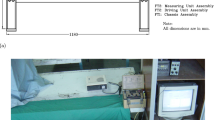Abstract
Single crystal,c-axis oriented sapphire filaments have been tension tested as a function of surface conditions and environment, and as a function of strain-rate. Filaments in the as-grown condition were shown to have failure strengths independent of the amount of water in the environment when tested at 0.002 min−1. This independence was correlated with fractographic determinations showing internal nucleation of fracture. In contrast, introduction of surface flaws was shown to reduce the strength to a level dependent upon the moisture content of the test environment. Filaments having as-grown surfaces were shown to fail at strength levels dependent upon the strain-rate. When the latter was increased stepwise in order of magnitude from 0.002 to 2.0 min−1, the fracture strength increased by a total of ∼ 70 kg mm−2, or ∼ 30% of the lowest average value. It is argued that the latter behaviour is different from static fatigue and that it is consistent with the Orowan model of subcritical crack extension in brittle materials. Experimental data are used to calculate background flaw sizes in the range of 0.22 to 0.39 μm and maximum crack extension at the slowest rate (0.002 min−1) of 0.15 μm.
Similar content being viewed by others
References
A. A. Griffith,Trans. Roy. Soc. A221 (1921) 163.
G. R. Irwin, “Fracturing of Metals” (A.S.M., Cleveland, Ohio, 1948) p. 147.
E. Orowan,Rep. Prog. Phys. 12 (1949) 185.
Idem, Weld. J. 34 (1955) 157
W. B. Hillig andR. J. Charles, “High Strength Materials” (Ed. V. H. Zackay) (Wiley, New York, 1965) p. 682.
R. E. Mould andR. D. Southwick,J. Amer. Ceram. Soc. 42 (1959) 542.
Idem, ibid 42 (1959) 582.
R. J. Charles andR. R. Shaw, General Electric Laboratory Report No. 62-RL-3081M (1962), General Electric Co. of America.
S. M. Wiederhorn,Inter. J. Fracture Mech. 4 (1968) 171.
Idem, “Environmental Sensitive Mechanical Behavior of Materials” (Eds. A. R. C. Westwood and N. S. Stoloff) (Gordon and Breach, New York, 1966).
S. M. Wiederhorn,J. Amer. Ceram. Soc. 50 (1967) 407.
J. Congleton andN. J. Petch,Acta. Metallurgica 14 (1966) 1179.
J. Congleton, N. J. Petch, andS. A. Shiels,Phil. Mag. 19 (1969) 1795.
H. E. Labelle,Mat. Res. Bull. 6 (1971) 571.
G. F. Hurley andJ. T. A. Pollock,Met. Trans. 3 (1972) 397.
J. T. A. Pollock,J. Mater. Sci. 7 (1972) 631.
Idem, ibid 7 (1972) 649.
G. F. Hurley,ibid 7 (1972) 471.
A. H. Heuer,Proc. Brit. Ceram. Soc. 15 (1970) 173.
H. E. Labelle andG. F. Hurley,S.A.M.P.E. Journal 6 (1970) 17.
F. C. Mallinder andB. A. Proctor,Phil. Mag. 13 (1966) 197.
M. L. Kronberg,J. Amer. Ceram. Soc. 45 (1962) 274.
H. Conrad, G. Stone, andK. Janowski,Trans. Met. Soc. AIME 233 (1965) 889.
E. Orowan, “Fracture” (Eds. B. L. Averbach, D. K. Felbeck, G. T. Hahn and D. A. Thomas (MIT Press, Cambridge, Mass., 1959) p. 225.
E. Stofel andH. Conrad,Trans. Met. Soc. AIME 227 (1963) 1053.
R. W. Rice, “Proc. of the Symposium of Ceramics in Severe Environments” (Eds. W. W. Kriegel and H. Palmour III) (Plenum Press, New York, 1971) p. 195.
Author information
Authors and Affiliations
Rights and permissions
About this article
Cite this article
Pollock, J.T.A., Hurley, G.F. Dependence of room temperature fracture strength on strain-rate in sapphire. J Mater Sci 8, 1595–1602 (1973). https://doi.org/10.1007/BF00754895
Received:
Accepted:
Issue Date:
DOI: https://doi.org/10.1007/BF00754895




